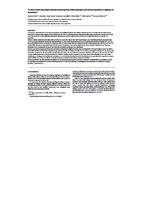Repositorio Digital
To what extent does depression influence quality of life of people with pharmacoresistant epilepsy in Argentina?
- DSpace Principal
- →
- Hospital El Cruce
- →
- Publicaciones
- →
- Artículos
- →
- Ver ítem
JavaScript is disabled for your browser. Some features of this site may not work without it.
Mostrar el registro sencillo del ítem
| dc.contributor.author | Scévola, Laura | |
| dc.contributor.author | Sarudiansky, Mercedes | |
| dc.contributor.author | Lanzillotti, Alejandra | |
| dc.contributor.author | Oddo, Silvia | |
| dc.contributor.author | Kochen, Silvia | |
| dc.contributor.author | D'Alessio, Luciana | |
| dc.date.accessioned | 2018-01-25T19:24:05Z | |
| dc.date.available | 2018-01-25T19:24:05Z | |
| dc.date.issued | 2017 | |
| dc.identifier.citation | To what extent does depression influence quality of life of people with pharmacoresistant epilepsy in Argentina? Scévola, Laura et al. Epilepsy & Behavior , Volume 69 , 133 - 138 | es_AR |
| dc.identifier.issn | 1525-5050 | |
| dc.identifier.uri | http://dx.doi.org/10.1016/j.yebeh.2017.01.007 | |
| dc.identifier.uri | http://repositorio.hospitalelcruce.org/xmlui/handle/123456789/571 | |
| dc.description | Fil: Kochen, S. Hospital de Alta Complejidad en Red El Cruce Dr. Néstor C. Kirchner. Centro Nacional de Alta Complejidad en Neurociencias y Neurocirugía. Florencio Varela, Argentina. | es_AR |
| dc.description.abstract | Introduction: Depression is the most frequent psychiatric co-morbidity in patients with epilepsy. Lifetime prevalence of depression is reported more frequently in temporal lobe epilepsy and is estimated at 35%. This co-morbidity appears to be related with various mechanisms. The aim of this study was to determine the quality of life (QoL) of patients with pharmacoresistant epilepsy with and without co-morbid depression in an Argentinean population. Methods: Patients admitted to the video-EEG monitoring unit during the period 2010–2013 went through a standardized psychiatric assessment using SCID-I (Structured Clinical Interview for Axis I diagnoses of DSM-IV), BDI II (Beck Depression Inventory) GAF (Global assessment of functioning), and Q LES Q-SF (for quality of life). Patients were divided in two groups: with and without depression (according to DSM-IV). Sociodemographic data, BDI II scores, GAF, and quality of life (QoL) were compared between the two groups. Comparisons were made using Student's t-test and Mann–Whitney U test. Frequency distributions were compared by Chi-square test. Spearman correlation coefficients were determined. Results: Seventy-seven patients with pharmacoresistant epilepsy were eligible for this study, 41 patients were included in the group with depression (mean BDI II 15.93), and 36 in the group without depression (mean BDI II 3.36) (p = 0.001). The overall QoL was significantly lower in the group with depression compared to the group without depression (p < 0.01). The most affected areas were: physical health (p = 0.013), mood (p = 0.006), course activities (referring to school as well as to hobbies or classes outside of school) (p = 0.003), leisure time activities (p = 0.011), social activities (p = 0.047), general activities (p = 0.042), and medication (p = 0.022). Severity of depression according to BDI II had a negative correlation with overall QoL (r - 0.339, p < 0.01). No correlations were found between seizure frequency, QoL and BDI II. Conclusion: Patients with pharmacoresistant epilepsy and co-morbid depression reported worst QoL. Depression disrupts daily functioning (leisure, social functioning) and is a negative influence for subjective perception of health and medication. Interdisciplinary treatment should be considered (neurology–psychiatry–psychotherapy). | es_AR |
| dc.language.iso | en_US | es_AR |
| dc.publisher | Epilepsy & Behavior | es_AR |
| dc.subject | Epilepsia | es_AR |
| dc.subject | Depresión | es_AR |
| dc.subject | Calidad de Vida | es_AR |
| dc.subject | Comorbilidad | es_AR |
| dc.subject | Argentina | es_AR |
| dc.title | To what extent does depression influence quality of life of people with pharmacoresistant epilepsy in Argentina? | es_AR |
| dc.type | Article | es_AR |
Ficheros en el ítem
Este ítem aparece en la(s) siguiente(s) colección(ones)
-
Artículos
Articles

